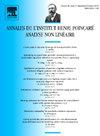黎曼激波下对流-反应-扩散方程无粘极限的一致渐近稳定性
IF 2.2
1区 数学
Q1 MATHEMATICS, APPLIED
Annales De L Institut Henri Poincare-Analyse Non Lineaire
Pub Date : 2022-01-31
DOI:10.4171/aihpc/90
引用次数: 6
摘要
本文的贡献证明了标量平衡律的稳定黎曼激波的粘性正则化的渐近轨道稳定性,一致地关于粘度/扩散参数$\epsilon$。均匀性的理解是,稳定性声明中涉及的所有常数都是均匀的,当限制到远离激波位置的函数时,相应的多尺度$\epsilon$依赖拓扑减少到经典的$W^{1,\infty}$ -拓扑。主要困难包括均匀性排除了任何使用抛物线正则化来关闭正则性估计,全局实时分析也是空间多尺度的,因为非平凡的慢部分与快速激波层部分共存,极限光滑光谱问题(在快速变量中)没有光谱间隙,并且均匀性需要非常精确和不寻常的相移编码轨道稳定性设计。特别是,我们的分析建立了一个相位,该相位以某种方式插入了Rankine-Hugoniot条件规定的双曲激波位置和仅由逐步淘汰非衰减$0$ -模式引起的非均匀位移之间,如在经典稳定性分析中对反应扩散方程的前沿。本文章由计算机程序翻译,如有差异,请以英文原文为准。
Uniform asymptotic stability for convection–reaction–diffusion equations in the inviscid limit towards Riemann shocks
The present contribution proves the asymptotic orbital stability of viscous regularizations of stable Riemann shocks of scalar balance laws, uniformly with respect to the viscosity/diffusion parameter $\epsilon$. The uniformity is understood in the sense that all constants involved in the stability statements are uniform and that the corresponding multiscale $\epsilon$-dependent topology reduces to the classical $W^{1,\infty}$-topology when restricted to functions supported away from the shock location. Main difficulties include that uniformity precludes any use of parabolic regularization to close regularity estimates, that the global-in-time analysis is also spatially multiscale due to the coexistence of nontrivial slow parts with fast shock-layer parts, that the limiting smooth spectral problem (in fast variables) has no spectral gap and that uniformity requires a very precise and unusual design of the phase shift encoding orbital stability. In particular, our analysis builds a phase that somehow interpolates between the hyperbolic shock location prescribed by the Rankine-Hugoniot conditions and the non-uniform shift arising merely from phasing out the non-decaying $0$-mode, as in the classical stability analysis for fronts of reaction-diffusion equations.
求助全文
通过发布文献求助,成功后即可免费获取论文全文。
去求助
来源期刊
CiteScore
4.10
自引率
5.30%
发文量
62
审稿时长
>12 weeks
期刊介绍:
The Nonlinear Analysis section of the Annales de l''Institut Henri Poincaré is an international journal created in 1983 which publishes original and high quality research articles. It concentrates on all domains concerned with nonlinear analysis, specially applicable to PDE, mechanics, physics, economy, without overlooking the numerical aspects.

 求助内容:
求助内容: 应助结果提醒方式:
应助结果提醒方式:


